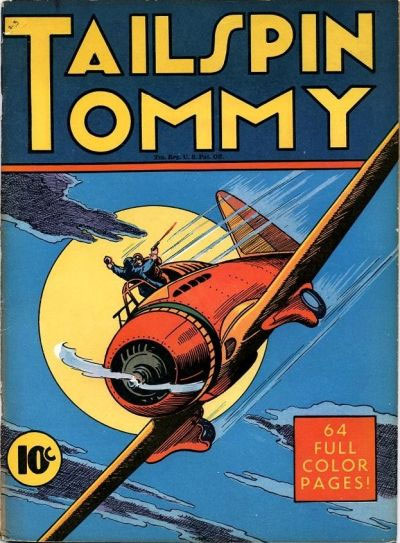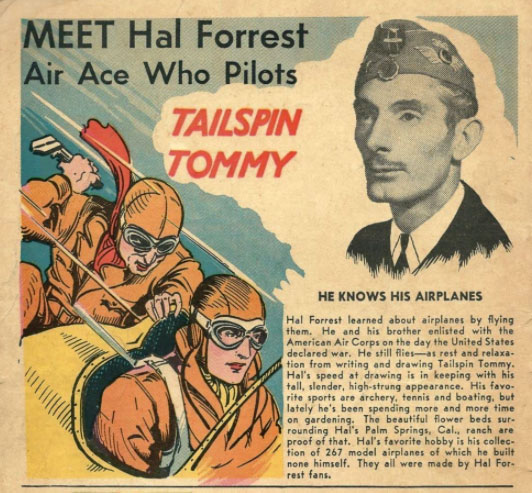'Tailspin Tommy' Sunday page, 29 May 1932.
Hal Forrest was an American comic artist and the creator of the first aviation comic strips in history: 'Artie the Ace' (1926-1927) and 'Tailspin Tommy' (1928-1942). At the time, 'Tailspin Tommy' spawned various media adaptations, including radio plays, books, a full-blown magazine and several movies. In fact, the brave aviator was the first comic character ever to inspire a film serial!
Early years
Harry Paul Forrest was born in 1892 in Philadelphia, Pennsylvania. Conflicting sources claim he was either born in 1893 or 1895, but Alex Jay of the Stripper's Guide blog found 1892 as the exact date on Forrest's military draft card. Forrest was the son of an insurance agent. Between 1911 and 1915 the young man went to the Art Institute of Chicago, and he combined his education with an illustrator job at The Chicago Tribune.
Early comics
In 1911, Forrest created 'Percy the Boy Scout', a gag comic which ran in the Philadelphia Telegraph. In 1914 he tried to enlist in the Royal Flying Corps, but was rejected because of athlete's foot. Between 1915 and 1917, Forrest served in the infantry as a member of the Headquarters Troop. Between 16 January and 13 February 1916 Forrest created an untitled gag comic for the Philadelphia Record about a little boy named Willie. By lack of a title, the Stripper's Guide's Allan Holtz has named this series 'Willie'. The comic ran as a strip for four episodes, with one half page on 2 April 1916. Certain sources claim Forrest and Lee Pape, author of 'Little Benn's Notebook', co-drew a Sunday funnies page in color for The Philadelphia Record, though Allan Holtz has cast doubts over this claim.
When the United States got involved in the First World War in 1917, Forrest was drafted. He worked as an aviator within the Signal Corps in San Antonio, Texas, rising up to the rank of sergeant-major. Meanwhile he kept creating comics and cartoons for the Bureau of Public Information. He was art editor of The Set-Up, a camp newspaper in Waco, Texas, while he also made cartoons for the newspaper of squadron Kelly Field: the Kelly Field Eagle. During the 1920s Forrest served at Clover Field in Santa Monica, California.
Artie the Ace
Between 1926 and 1927, Forrest created a newspaper comic for the Paramount Newspaper Syndicate, 'Artie the Ace'. It dealt with the adventures of a bumbling airline pilot. The character is a predecessor to his later series 'Tailspin Tommy', though the tone of 'Artie the Ace' is humorous rather than serious. Historically, 'Artie the Ace' is important as the first aviation comic in history, though that honorific title usually goes to 'Tailspin Tommy'. Mostly because it ran longer and was more successful, but also because it appears that 'Artie the Ace' might not have had a wide circulation outside of local military magazines.
Fifth episode of 'Tailspin Tommy' (1928).
Tailspin Tommy
In the early 20th century, aviation was still in its infancy, but the First World War had proven its benefits in terms of transport, so during the 1910s and 1920s airline companies were gradually established all over the world. In 1927, American pilot Charles Lindbergh became the first person to fly solo across the Atlantic Ocean. The flight made him world famous and increased the public demand for stories about brave aviators. Walt Disney's very first 'Mickey Mouse' cartoon, 'Plane Crazy' (1927) directly referenced Lindbergh's flight. John N. Wheeler, owner of Bell Syndicate, felt a newspaper comic strip about an aviator might be a hole in the market. He hired crime reporter and press agent Glenn M. Chaffin (15 May 1897 - 28 February 1978) to write stories. Chaffin had served in the U.S. Navy during World War I and scripted Lovrien Gregory's gold rush comic 'The Pioneers' (1928-1929). Since Forrest had already drawn 'Artie the Ace' and was experienced in aviation matters, he picked up the pencil.
'Tailspin Tommy', 2 February 1931.
On 21 May 1928, the first episode of 'Tailspin Tommy' was published in the Oakland Tribune. The hero, Tommy Tomkins from Littleton, Colorado, earns his nickname due to his childhood love for airplanes. One day, young Tommy notices an airplane making an emergency landing. He helps the mail pilot who introduces himself as Milt Howe. As a sign of gratitude for saving his life, Howe takes Tommy along to Three Point Airlines in Texas, where he becomes an airplane repairman. Soon the kid becomes a pilot himself. Tommy's best friend is co-pilot Peter Milligan, nicknamed "Skeeter". Tommy's love interest Betty Lou Barnes works for the same company.
'Tailspin Tommy' was a realistically drawn drama series. The characters use professional aviation jargon and all planes are depicted with eye for detail. Chaffin and Forrest often took the time to provide their readers with didactic intermezzos. The storylines themselves, however, are far more action-packed, sometimes bordering on the outlandish. Tommy and his crew not only delivered cargo, but also went on treasure hunts, fought sky pirates, survived bad weather and discovered unknown civilizations. The series instantly caught on. By January 1929 its circulation had grown to 60 papers. On 20 October of that same year, a Sunday page was added. In 1931 the adventures of Tommy could be read in more than 250 newspapers all across the USA. The comic strip was also popular in French ('Jean Bolide') and Swedish translations.
'Tailspin Tommy', 21 May 1933.
Topper comics
Between 27 April 1930 and 31 December 1933, the Sunday page of 'Tailspin Tommy' came with an educational panel titled 'The Progress of Flight'. This was a history lesson about aviation pioneers like the Brothers Wright and Louis Blériot. On 7 January 1934 this topper comic was replaced by an additional adventure comic, 'The Four Aces' (1934-1941), about a group of World War I aviators and their post-war adventures. Other topper comics were launched as well, with self-explanatory titles like: 'How to Fly' (1935), 'War Plane Insignia' (1935) and 'Tailspin Tommy Flying Club' (1935-1941).
'The Four Aces' (Quebec publication in Le Soleil, 3 March 1934).
Radio adaptations
At the time, 'Tailspin Tommy' was popular enough to inspire no less than three radio audio play adaptations. On 20 June 1929, 'Tailspin Tommy Flies to Fame' was broadcast on KDKA. CBS Radio produced another audio play series from 16 June 1934 on, followed by a final one from 5 September 1941 on. This latter version starred Jack Arnold as Tommy, Earl Hammond as Skeeter and Dorothy Scott as Betty Lou.
Films
In 1934, Universal Studios produced a 12 episode movie serial about 'Tailspin Tommy', in fact the very first film serial based on a comic strip character! Maurice Murphy took the part of Tommy, Noah Beery Jr. Skeeter and Patricia Farr Betty Lou. A year later Universal made a follow-up, 'Tailspin Tommy & the Great Air Mystery', but only Beery returned as Skeeter. This time, Clark Williams played Tommy, while Jean Rogers starred as Betty Lou. Monogram Pictures also developed four feature films around Tailspin Tommy, namely: 'Mystery Plane' (1939), 'Stunt Pilot' (1939), 'Sky Patrol' (1939) and 'Danger Flight' (1939), with John Trent in the role of Tommy. Milburn Stone played Skeeter and Marjorie Reynolds appeared as Betty Lou. Two extra films were planned but scrapped since the audience reception left a lot to be desired.
"Telecomic" version of 'Tailspin Tommy'.
Book publications
In 1933, Stephen Slesinger Inc. published 30 volumes of 'Tailspin Tommy Adventures' in booklets of eight pages each. They came as free gifts with Big Thrill Chewing Gum. Slesinger also made some primitive animated images, or "synoptic films" under the title 'Telecomic Films'. These were little paper strips with images that could be put into a small projector with a hand crank. The projector then illuminated and switched between these images to give the viewer the impression of motion. Slesinger later also published several 'Tailspin Tommy' installments in his Big Little Books series, written by Gaylord Du Bois with illustrations by Hal Forrest. In 1936 Mark Stevens wrote a novel titled 'Tailspin Tommy: The Mystery of the Midnight Patrol' (Grosset & Dunlap, 1936).
Comic books and magazines
During the 1930s, 'Tailspin Tommy' episodes were reprinted in the Dell Comics titles 'The Funnies' and 'Popular Comics' and in Eastern Color Printing's 'Famous Funnies'. In July 1939, United Feature Syndicate took over 'Tailspin Tommy' from its subsidiary Bell Syndicate and published a pair of comic books starring the pilot, one as an issue of the 'Single Series' (1940), the other a stand-alone title (1946). In October 1936 CHJ Publications launched a pulp magazine titled Tailspin Tommy Adventure Magazine. One of the contributors was Fred Meagher. Yet the magazine only lasted two issues because the rights to the character hadn't been sufficiently cleared. In January 1937 the second and final issue rolled from the presses.
Tailspin Tommy, 'Single Series' #23.
Controversy and cancellation
While 'Tailspin Tommy' was a success, Forrest often argued with his scriptwriter Glenn Chaffin, which led the latter to leave the series on 7 January 1934. From that moment on, Forrest had to write his own scripts, while drawing the series as well. Chaffin went on to become a scriptwriter for Irvin Shope's 'Rusty Rawlins' (1934-1936) and Russell Keaton's 'Flyin' Jenny' (1944-1946). From September/November 1935 until 15 March 1942 Forrest hired a young college student as inker and ghost artist: Reynold Brown. Brown himself also took an assistant inker, with the name "Lloyd". While Brown's artwork was vastly superior over Forrest's, the men didn't get along. On 15 March 1942, Reynold Brown left the series. By lack of a successor Forrest was forced to terminate 'Tailspin Tommy' altogether.
Brown's reasons for leaving are still a matter of debate. He considered Forrest an ungrateful taskmaster, though at the same time, plans for a possible spin-off which credited Brown exist. It is however unclear whether these were intended for publication or just an idea in development hell. Brown's sister, Lorraine, claimed that 'Tailspin Tommy' had to close down under government pressure because the comic depicted secret warfare tactics. What remains a fact is that by the late 1930s, many papers started to drop 'Tailspin Tommy'. Far superior aviation comics started to fly past it and made Forrest's series look increasingly outdated by comparison. Perhaps Brown's major reason for quitting the series was that it had been advised to him that he would never be able to make a career as an illustrator if he remained a comic artist. Indeed, Brown never returned to the comic industry again.
Final years and death
Hal Forrest illustrated Joyce E. Newbill Martin's children's book, 'Alan and Benda on a Clipper' (1942). In the 1950s a man named "Hal Forrest" acted in a few B-movies and series, though it's unclear whether it's the same person. He played Dr. Nedring in 'Abbott & Costello Go to Mars' (1953) and had a recurring role as Secretary General Edward Carlisle in 'Space Patrol' (1953-1954). Either way, Hal Forrest passed away in his home in Culver City, California, on 21 November 1959 (although the Associated Press newspaper reports at the time said he died on Monday 23 November).
Legacy and influence
While now mostly a relic of the 1920s, 1930s and 1940s, 'Tailspin Tommy' is still on record as the first aviation comic. It paved the way for many other aviation comic series like Ernest Henderson's 'Flying to Fame' (1928), Eddie Stinson and Elmer Woggon's 'Skylark' (1928-1929), Lyman Young's 'Tim Tyler's Luck' (1928), Lester J. Maitland and Dick Calkins' 'Skyroads' (1929), John Terry's 'Scorchy Smith' (1930), Zack Mosley's 'Smilin' Jack' (1933-1973), William Ritt & Clarence Gray's 'Brick Bradford' (1933), Milton Caniff's 'Terry and the Pirates' (1934) and 'Steve Canyon' (1947), Frank Miller's 'Barney Baxter' (1935), Russell Keaton's 'Flyin' Jenny' (1939), Roy Crane's 'Buz Sawyer' (1943), Frank Robbins' 'Johnny Hazard' (1944) and Ray Bailey's 'Bruce Gentry' (1945), to name a few contemporaries.
Hal Forrest.












